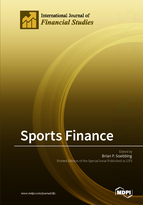Sports Finance
A special issue of International Journal of Financial Studies (ISSN 2227-7072).
Deadline for manuscript submissions: closed (1 January 2015) | Viewed by 58703
Special Issue Editor
Special Issue Information
Dear Colleagues,
The use of sport as an empirical setting to study different organizational and economic phenomena is continuously increasing (Day et al., 2012; Kahn, 2000; Wolfe et al., 2005). Specifically, in the finance literature, sports have been used to examine market efficiency (e.g., Edmans et al., 2007; Golec & Tamarkin, 1991; Gray & Gray, 1997, Woodland & Woodland, 1997), the financing of sports facilities (Baade & Matheson, 2006; Coates & Humphreys, 2003; Rebeggiani, 2006), and mega events (Madden, 2006).
In addition, sports have many unique qualities, which contribute to an industry generating revenues estimated between 44 and 60 billion dollars in the United States (Humphreys & Ruseski, 2009). The study of sports has emerged both as an academic major and as a field of research, with sports financing being one of the main areas of scholarship in the field of research. Thus, the primary goal of this Special Issue will highlight sports’ activities as an empirical setting for understanding financial phenomena and will highlight sports’ unique financial idiosyncratic characteristics. Topics in this Special Issue can include, but are not limited to, non-profit sports clubs, mega events, financial issues related to stadiums and arenas, amateur and professional sports leagues and teams, and gambling markets, including sports betting, lotteries, and other games of chance.
Dr. Brian P. Soebbing
Guest Editor
Manuscript Submission Information
Manuscripts should be submitted online at www.mdpi.com by registering and logging in to this website. Once you are registered, click here to go to the submission form. Manuscripts can be submitted until the deadline. All submissions that pass pre-check are peer-reviewed. Accepted papers will be published continuously in the journal (as soon as accepted) and will be listed together on the special issue website. Research articles, review articles as well as short communications are invited. For planned papers, a title and short abstract (about 100 words) can be sent to the Editorial Office for announcement on this website.
Submitted manuscripts should not have been published previously, nor be under consideration for publication elsewhere (except conference proceedings papers). All manuscripts are thoroughly refereed through a single-blind peer-review process. A guide for authors and other relevant information for submission of manuscripts is available on the Instructions for Authors page. International Journal of Financial Studies is an international peer-reviewed open access quarterly journal published by MDPI.
Please visit the Instructions for Authors page before submitting a manuscript. The Article Processing Charge (APC) for publication in this open access journal is 1800 CHF (Swiss Francs). Submitted papers should be well formatted and use good English. Authors may use MDPI's English editing service prior to publication or during author revisions.
Keywords
- sports
- gambling
- risk
- mega-sport events
- non-profit sports activities
- professional sports
- amateur sports
- sports clubs






